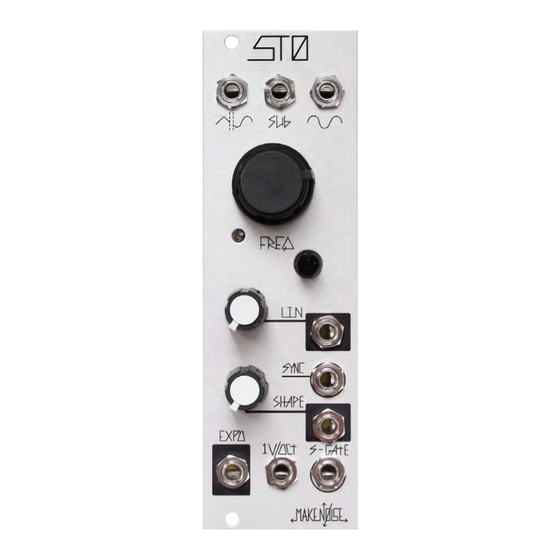
Advertisement
Quick Links
Advertisement

Summary of Contents for Make Noise STO
- Page 1 v2.5...
-
Page 2: Table Of Contents
Limited Warranty ----------------------------------------------------3 Installation --------------------------------------------------4 Overview --------------------------------------------------------5 Panel Controls -----------------------------------------------------6 The Waveform Outputs -------------------------------------7 FM, SYNC, and Variable Shape ---------------------------------8 Patch Ideas -------------------------------------------------------9... -
Page 3: Limited Warranty
Make Noise to be the fault of the user are not covered by this warranty, and normal service rates will apply. During the warranty period, any defective products will be repaired or replaced, at the option of Make Noise, on a return-to-Make Noise basis with the customer paying the transit cost to Make Noise. -
Page 4: Installation
Eurorack style bus board, minding the polarity so that the RED stripe on the cable is oriented to the NEGATIVE 12 Volt line on both the module and the bus board. On the Make Noise 6U or 3U Busboard, the negative 12 Volt line is indicated by the white stripe. -
Page 5: Overview
Shape, but this VCO seems destined for melody. The STO uses a Triangle Core and has outputs for Sine, SUB, and Variable Shape. The Sine is shaped from the Triangle using the same circuit used on the DPO. The Sub-Oscillator has its own gate input that lets the user turn it on/o at will. The Variable SHAPE ripples both Even and Odd Harmonics resulting subtle timbral shifts where the fundamental frequency is never masked. -
Page 6: Panel Controls
STO Panel Controls 1. Variable Shape Waveform Output: 10Vpp 2. Sub-Oscillator Output: 12Vpp 3. Sine Waveform Output: 10Vpp 4. Coarse Tune panel control: 9 octave range 8hz-4khz 5. 1V/Octave Scale Trimmer (Calibration Use Only)) 6. Fine Tune panel control: +/-2.5 semi-tone range 7. -
Page 7: The Waveform Outputs
Sub-Oscillator, allowing it to have rythymic or percussive patterns not associate with the other outputs of the STO. If more narrow signal is used at this input, such as Saw from VCO A on the DPO, it is possible to create sync type sound in the Sub-Oscillator while the other outputs, Sine, and Variable Shape, are not a ected. -
Page 8: Fm, Sync, And Variable Shape
SYNC patches introduce strong harmonics to all of the outputs on the STO. Sync uses a modulation method where the core of the STO is made to conform to that of an external VCO. Once SYNC'd the STO core restarts its period at each cycle of the external VCO signal, so they will have the same base frequency. -
Page 9: Patch Ideas
The Sub Timbral Voice: Patch Variable Shape output to AC input of MMG. Patch Sub-Osc output to DC input of MMG. Set STO Freq to around 12:00. Set MMG input attenuator to 1:00, MMG Freq full counter clockwise, MMG Q to 11:00 and Mode to LP. Patch slow LFO logarithmic from MATHS to Shape CV Input on STO and set Shape attenuator to about 60%. - Page 10 Transposition/Superimposition Patch a sequence such as from Rene to the STO’s 1V/Oct input. Patch another sequence of a di erent speed, or control voltage from a keyboard, to the Expo input. The two sequences will be “added” together for transposition. Variations would include: clocking the transposing sequence at an odd division of the master clock, resulting in long periods between exact repetitions;...
- Page 11 Patch a low-frequency square wave (or EOR/EOC gate from cycling MATHS, FUNCTION, or CONTOUR) to the S-Gate input, and take output from SUB Out. Mult the square wave to the Clock input of a sequencer and patch the sequencer’s output to the STO...

Need help?
Do you have a question about the STO and is the answer not in the manual?
Questions and answers